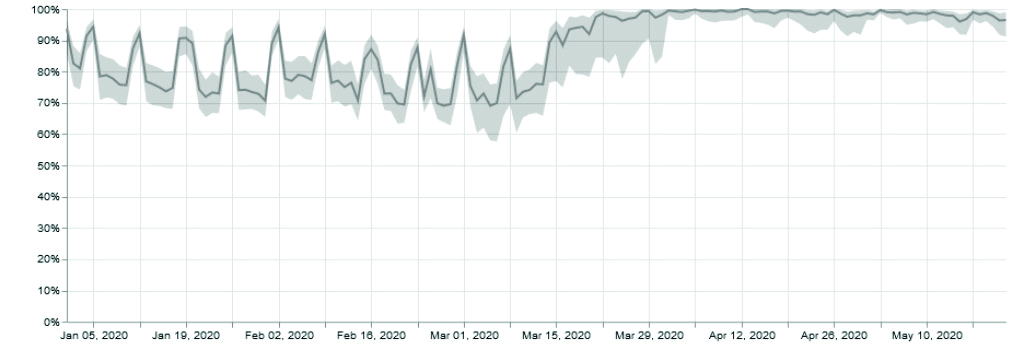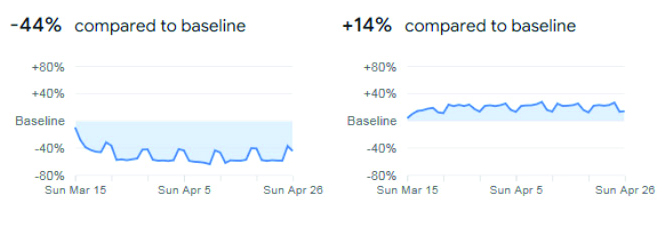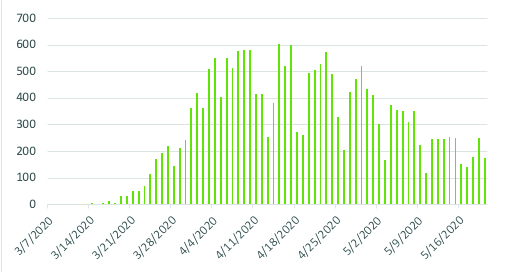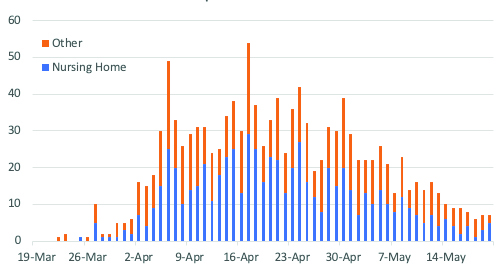Background
On May 22, 2020, Pennsylvania Governor Wolf announced that effective June 5, Philadelphia County would be permitted to ease movement and business restrictions consistent with the “Yellow” phase in his Process to Reopen Pennsylvania. This document is a strategy for how Philadelphia will approach the easing of these movement and business restrictions while continuing to suppress the spread of the virus.
Impact and progress
Philadelphia has used many sources of data to measure the impact of COVID-19 on residents, determine which residents were at greatest risk, evaluate the effectiveness of the response, and guide decision-making.
As of May 23, 2020, there were 21,234 Philadelphia residents with confirmed COVID-19 infection. It is likely that far more residents had the infection without the virus being detected. Of those with confirmed infection, 1,233 (5.8 percent) died from COVID-19. While infection rates were evenly distributed among adults of all ages, fatalities were far more common among older adults, with 69 percent of deaths occurring in those over age 70, and 88 percent of deaths occurring in those over age 60. People living in nursing homes were at the greatest risk; of the 1,233 Philadelphia residents who died from the COVID-19 infection, 654 (53 percent) lived in long-term care facilities.
To reduce the spread of COVID-19, schools were closed in Philadelphia on March 13, most businesses were closed on March 17, and a statewide stay-at-home order was issued on March 22. These changes were followed by increases in the time each day Philadelphians spent at home from 75 percent before the stay-at-home order to 95 percent, according to cell phone-generated data provided by SafeGraph.

According to cellphone data analyzed by Google, after the stay-at-home order there was a greater than 60 percent decrease in time spent in retail stores.
These restrictions on movement and interactions among people caused the epidemic to subside. The epidemic began in early March and peaked in mid- April, approximately four weeks after the business closures, during which more than 500 people per day were diagnosed with the COVID-19 infection. By the third week of May 2020, case counts had fallen to approximately 200 per day.




Approximately ten days after the peak of the community-wide epidemic, the number of patients with COVID-19 infection receiving inpatient care at Philadelphia hospitals peaked, putting some hospitals under strain and prompting some hospitals to open surge-space beds and transfer patients to other facilities. However, by May 22, 2020, the number of patients with COVID-19 infection in Philadelphia hospitals had fallen more than 45 percent from the peak on April 27.
Deaths from COVID-19 infection peaked in the third week of April, both in the community and in nursing homes, and have fallen substantially since then.

Risks
Despite this remarkable progress, COVID-19 has the potential to infect and kill many more Philadelphia residents and commuters. A reasonable estimate is that as of late May, 10 percent of people in Philadelphia have been infected by the virus, leaving the other 90 percent vulnerable. The COVID-19 virus remains unchanged in its potential to spread widely throughout the community, strain the hospital system, and cause spikes in death. An effective vaccine is likely at least 18 months away from widespread use. The City of Philadelphia is therefore just as vulnerable to a new epidemic of COVID-19 in June as it was in March. If residents and commuters resume pre-epidemic social activities and businesses operate using unsafe practices, this region will experience a new and potentially larger wave of infections, hospitalizations, and deaths.
At the same time, the economic and social consequences of the stay-at-home order are significant. New unemployment claims in Philadelphia rose nearly tenfold from the week of March 14 (16,537) to the week of May 2 (155,983).* There are well-known adverse health consequences to unemployment and poverty; mortality rates are substantially higher and life expectancy shorter in people who are unemployed or have lower incomes.
(*There are well-known adverse health consequences to unemployment and poverty; mortality rates are substantially higher and life expectancy shorter in people who are unemployed or have lower incomes.)
Objectives
Philadelphia must approach Phase 2 of the COVID-19 epidemic in a way that balances the risks of the virus with the public health risks caused by further social and economic damage from movement and business restrictions. The path forward must be solidly based on science, available evidence about how the virus behaves, and a cautious approach that acknowledges the many things we do not yet know about this virus. South Korea has suppressed the virus with a combination of moderate social distancing steps, rapid case identification, contact tracing, and other case containment activities. This country’s successful approach serves as a good model for Philadelphia.
This is a strategy for Philadelphia for the next phase of epidemic control that allows economic and social activity to resume in a way that continues to suppress the COVID-19 virus. The strategy combines three actions: Containment, Social Distancing, and Protecting Vulnerable Populations. Because there are constant changes to the groups of people infected by the virus, the biomedical tools to prevent and treat it, and the behavior of Philadelphians, this strategy is likely to be modified as it is implemented in the coming months.
Shared responsibility for recovery
As Philadelphia and the surrounding region begin to enter a phased reopening, it is on all of us—residents, government officials and agencies, businesses, health care providers, and more—to ensure our city is able to make a full recovery. The City is committed to emerging from this months-long shutdown as quickly as possible, but we need everyone to do what is right and continue following the guidance provided by the Department of Public Health. It is clear from the Commonwealth’s decision to allow Philadelphia County to ease movement and business restrictions consistent with the “Yellow” phase in Governor Wolf’s Process to Reopen Pennsylvania that the work of Philadelphians thus far has put us in a much safer position. But we are not out of the woods yet; COVID-19 is still present in our communities and poses a real threat if we don’t take things seriously as the city reopens. To successfully navigate the next phase of our recovery, we need all Philadelphians to embrace the shared responsibility we all have at this critical moment in our city’s history
